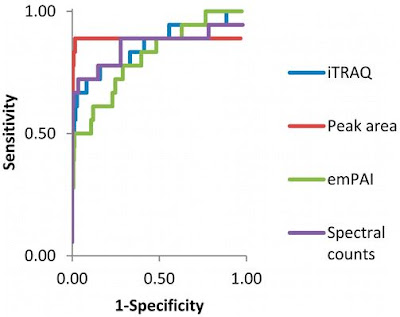Wednesday, February 1, 2017
Comparing quantification methods!
At first look -- I have absolutely NO idea what this chart is saying, but I'm interested in the fact that they are comparing multiple quantification approaches! If you're thinking "...wait...hasn't this been done 16 times before...?" Yup! But there are some subtle differences here, and it makes it interesting. (These researchers aren't un-knowledgeable of the past, they cite at least 15 previous publications in the introduction).
This is the paper, btw!
The idea here is to compare low-magnitude fold differences on Q-TOFs. They argue here, quite correctly, that not everyone has an Orbitrap and it is important to know how best to do quantification on the Q-TOF systems in relation to small differences in fold change.
Further details on the quantification methods compared:
1) iTRAQ 8-plex
2) Samples compared -- 18 proteins spiked into an E.coli digest at various levels
3) Data was processed with Mascot and Progenesis IQ
4) iTRAQ ratios were processed using an in-house approach based on using the reporter counts a student t-test and H&B approach was applied to FDR (they go into this at length -- and it seems pretty smart)
5) Worth noting -- if you're doing a student t-test, missing values are gonna mess things up, so in the case of these they just set the ratio to >10 fold.
What did they find? Spectral counting does really well compared to these other approaches -- both in sensitivity and in specificity (where something like a 1.1 fold difference needed to be detected -- it did really well).
My take-away -- this definitely makes sense to me! Q-TOFs aren't very sensitive, they don't have very good dynamic range, and they don't have a lot of resolution (compared to FTICR/OT systems) -- they are, however, extremely fast! When you have the capacity to get lots of MS/MS spectra per unit time a quantification method that markedly improves as the number of MS/MS spectra increases is probably going to win out -- and here it definitely does.
That sounded more negative than I wanted it to -- every instrument has it's own pros and cons. This paper shows how to leverage the pros of this instrument type (which I don't have a lot of experience with) to get the best possible quantification data -- and that is definitely a good thing!
Shoutout to whoever posted this on the Twitter spectral counting thread yesterday!
Subscribe to:
Post Comments (Atom)


Hi Ben, I've got a question about spectral counting. I've seen datasets with SpC for a given peptide >100. How can this be if dynamic exclusion is on? I mean, a peptide can pop up every now and then if the dynamic exclusion time is low. But I don't understand how you can do MS/MS of the same peptide hundreds of times if DE is on. Best wishes.
ReplyDeleteWow...Great question! Umm....100 PSMs for one peptide...that is pretty weird. Having hundreds for a big protein...that is normal...hundreds for a single peptide suggests that dynamic exclusion isn't set right (or, worse, isn't working right on your instrument).
DeleteHi Ben, thanks for answering. I asked because I was watching a presentation from Michael Washburn in Youtube (https://www.youtube.com/watch?v=YNhuA9iDvXw&t=301s). At 4min30 sec, he shows a slide where you can see big numbers in SpC for unique peptides. Some are in the hundreds range... But as you said, it may be that this is a big protein or maybe the sample is not that complex (he doesn't explain how he performed the experiment.)
DeleteAnonymous,
DeleteGotcha! I've visited that great lab before! Their first description of malaria parasites in mosquitoes is a paper I know almost by heart.
The runs he's describing might be 24 hours long (I don't think that has been uncommon for Mike's group). There is lots of chances to get lots of peptides. SCX fractionation is done online with the RPHPLC and even with a dynamic exclusion of 2, you might see the +2 (for example) version of the peptide in 2 or 3 SCX fractions. If this is LTQ data (video is from 2009) the LTQ will sometimes pick up an isotope outside of the DE range and fragment it as well -- also...a lot of peptides show up as +2 and +3 and you'll have that complication to deal with as well. I do think he is talking about seeing the protein, rather than the peptide, though. Hundreds of counts for a protein wouldn't be unusual at all. Hope this helps clarify!
That clarifies a lot! Thanks Ben.
ReplyDelete